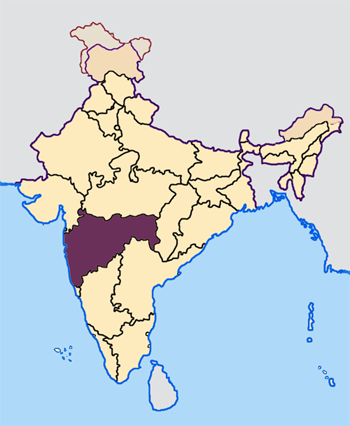Maharashtra: Difference between revisions
| Line 161: | Line 161: | ||
* [http://www.123bharath.com/maharashtra-india-news Maharashtra News] |
* [http://www.123bharath.com/maharashtra-india-news Maharashtra News] |
||
* [http://www.dte.org.in/ |
* [http://www.dte.org.in/Directorate of technical education] |
||
Revision as of 07:30, 23 June 2004

| |
| Date of formation | May 1, 1960 |
| Capital | Mumbai |
| Auxiliary Capital | Nagpur |
| Largest City | Mumbai |
| Governor | Mohammad Fazal |
| Chief Minister | Sushil Kumar Shinde |
| Area | 308,000 km² |
| Population - Total - Density | Ranked 2nd in India
322.5/km² |
| Literacy rate: - Total - Male - Female | 77.27% 86.27% 67.51% |
| Urbanization: | 42.11% |
| GSDP growth rate: | 4.0% (2002-03) |
Maharashtra is a state in western India. The basis for creation (demarcation) of the state in its present form on May 1, 1960 was linguistic majority (Marathi). Its population was 96,752,247 (2nd most populous state in India) as per provisional results of Census of India, 2001. Its capital is Mumbai, the economic powerhouse of India.
Only eleven countries of the world have a population greater than Maharashtra.
Maharashtra is the number one state in India in terms of getting foreign investment getting 17% of all foreign direct investment in India. 32% of all exports from India are from the state of Maharashtra as per economic survey of Government of Maharashtra in 2002-03.
Timeline
- 230 BC to 225 AD: ruled by the Satvahanas
- 250 to 525: The Vakatakas brought Vidharba under their rule.
- 550 to 760: Ruled by the Chalukyas
- 640 Chinese pilgrim Hiun Tsang visited Maharashtra
- 973: Rashtrakuta rule comes to an end
- 973 to 1180: Ruled by the Chalukyas
- 1189 to 1310: Ruled by the Yadavas of Deogiri
- 1296: Alla-ud-din Khilji, the first Muslim sultan of the North penetrates the Deccan, defeats the Yadavas and carried away a huge booty.
- 1658 - 1700 : Rise of Shivaji and followers -- period of rebellion against the Mogul empire (see Maratha empire).
- June 3, 1818: Bajirao II submitted to the British
- November 1, 1956: Bombay state formed of which Maharashtra was a part.
- May 1, 1960: Maharashtra takes its current form as a Marathi state.
See also: Shivaji, Social reform movement in Maharashtra
Geography
Maharashtra borders Goa and Karnataka on its south, Andhra Pradesh on its southeast, Gujarat, Dadra & Nagar Haveli, Daman and Madhya Pradesh on its north, Chhattisgarh on its east, and the Arabian Sea on its west.
Maharashtra comprises five regions - the coastal Konkan, Khandesh in the north, Desh in the centre, Marathwada in the southeast and Vidarbha in the northeast. Vidarbha was formerly part of Central Provinces and Berar, while Marathwada was part of the former princely state of Hyderabad.
Other cities include:
Rivers include:
- The Krishna River originates at Mahabaleswar, Maharashtra and passes through Sangli from where it enters Karnataka state and then meets the sea in the Bay of Bengal at Hamasaladeevi, Andhra Pradesh.
- The Godavari River rises at Trimbak, near Nasik and Mumbai in Maharashtra.
Economy
Maharashtra is one of the most advanced states in India, with a strong industrialized economy, and the largest power production and consumption in the nation.
Main items of export from Maharashtra
- gems and jewelry
- readymade garments
- sugar
- cotton yarn
- turmeric
- made-up fabrics
- machinery and instruments
- metal products
- agro-based products
- wine
Specialized Industrial Parks in Maharashtra
- Krishna Valley Wine Park, Palus, Sangli
- Nasik Wine Park, Nasik
- Sangli Food Park, Mane-Rajuri, Sangli
- Nagpur Food Park, Nagpur
Infotech /IT Parks
- SEEPZ, Mumbai
- Millenium Business Park, New Mumbai
- Hinjawadi IT Park, Hinjawadi, Pune
- Sangli IT Park, Vishrambag, Sangli
- Nagpur IT Park, Nagpur
Demographics
See: Konkani, Marathi language
Culture
The Indian film industry, commonly called Bollywood (the largest film industry in the world), is centered here.
It has a rich history, and has given birth to great warriors, like Shivaji, and Bajirao, and to national leaders, including M. G. Ranade and Lokamanya Tilak.
Transport and communications
Total road length: 266,000 km.
Total railroad length: 5,459 km. (8.6% of total railroad length in India)
Number of telephone lines: 6.074 million
Tourism
List of prominent shrines in Maharashtra
- Dehu
- Alandi
- Ghrishneshwar Temple
- Khuldabad
- Siddhivinayak Temple
- Jejuri
- Shirdi
- Ganapati Temple of Sangli
- Sangameshwar Shiva Temple, Haripur, Sangli
- Audumbar Near Sangli
- Khidrapur
- Meherabad
- Anwa Temple
- Ashta Vinayak
- Trimbakeshwar
- Narasimha Wadi Near Sangli
- Mahalaxmi Temple, Mumbai
- Bhimashankar
- Saptashringi Devi Temple
- Haji Ali Shrine
- Meherabad and Meherazad, near Ahmednagar, India
List of hill stations
List of Wild Life Sanctuaries
- Sanjay Gandhi National Park, Borivali, Mumbai
- Sagareshwar Wild Life Sanctuary, Near Sangli
- Chandoli Wild Life Sanctuary, Sangli district
Miscellaneous
Government resources
Colleges and universities
- Armed Forces Medical College, Pune
- Indian Institute of Technology, Bombay. IIT-B
- University of Mumbai, Bombay
- Walchand College of Engineering, Sangli
- Government Medical College, Miraj, Sangli
